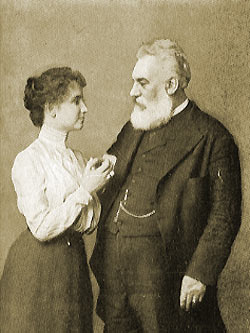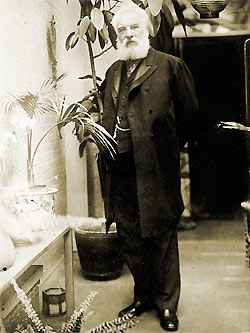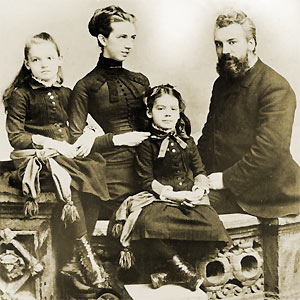 |
Biography |
||||||
March 3, 1847 - August 2, 1922 |
Alexander Bell was born in Edinburgh, the 3 march 1847. He was the second of the three sons of Alexander Melville Bell , a scientist and author in the field of vocal physiology and elocution, and of Eliza Grace Symonds (1809-97), the daughter of a surgeon in the Royal Navy. His grandfather, Alexander Bell (1790-1865), was a professor of elocution in London. From both sides of the family he inherited a scientific tendency and an instinct for applying knowledge to practise. During his earlier years he was taught at home, by his mother, a woman of admirable character who was also unusually gifted, a musician and painter of ability. From her Bell obtained his accuracy and sensitiveness of hearing and his love for music. |
|
 |
11 july 1877 : Mabel Hubbard and Bell are married. 8 may 1878 : Birth of their first daughter, Elsie May Bell and February 15, 1880, birth of their second daughter, Marian (Daisy) Bell. In 1882, Bell became a naturalized citizen of the United States. In 1888, he was one of the founding members of the National Geographic Society and became its second president. Bell first came to Baddeck in 1885 and returned the next year to establish a vacation home for his family, Beinn Bhreagh (Gaelic for 'beautiful mountain'), far from the formality and summer heat of Washington. He regularly spent a substantial part of the year at Beinn Bhreagh and both he and his wife, Mabel, played an active role in the social and intellectual life of the village. Mabel Bell was primarily responsible for the management of Beinn Bhreagh and was deeply involved in village life, helping to establish the local public library, and the Home and School Association as well as a club for young women to promote sociability and the acquisition of general knowledge. By the time of Bell's arrival in Baddeck, the success of the telephone had freed Bell from the need to earn a living. At Beinn Bhreagh, he continued his busy routine of experimentation and analysis. His imagination and wide-ranging curiosity led him into scientific experiments in such areas as sound transmission, medicine, aeronautics, marine engineering and space-frame construction. Bell can be considered an inventor, an innovator, an inspirer of others and a humanitarian. |
Alexander and Mabel Bell |
Alexander Graham Bell dies august 2, 1922 and Mabel Hubbard Bell January 3, 1923. They were buried on top of the mountain Beinn Bhreagh. The Bell's inventive genius is represented only in part by the eighteen patents granted in his name alone and the twelve he shared with his collaborators : fourteen for the telephone and telegraph, four for the photophone, one for the phonograph, five for aerial vehicles, four for hydroairplanes, and two for a selenium cell. Bell will win the majority of the 600 lawsuits brought against him by researchers like Elisha Gray or Thomas Edison, who will claim shares in the invention of the telephone. The French Government conferred on him the decoration of the Légion d'honneur (Legion of Honor), the Académie française bestowed on him the Volta Prize of 50,000 francs, the Royal Society of Arts in London awarded him the Albert medal in 1902. He was awarded the AIEE's Edison Medal in 1914 for "For meritorious achievement in the invention of the telephone." " When one door closes, another opens; but we often look so long and so regretfully upon the closed door that we do not see the one which has opened for us. ” Alexander Graham Bell |
 |
| Source : Smithsonian Institution - Fitzgerald Canada - Parks Canada - AT&T - National Geographic Magazine (Vol. XIV, No.6, June 1903) - Alexander Graham Bell National Historic Site - Dictionary of American Biography Base Set. American Council of Learned Societies, 1928-1936. Photos : Library and Archives Canada - Library of Congress American Memory - Smithsonian Institution - National Geographic |
Biography |
||||||
